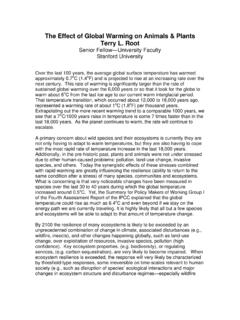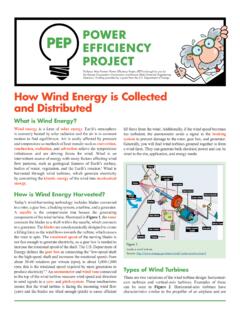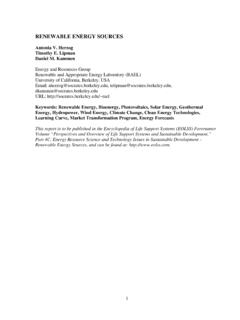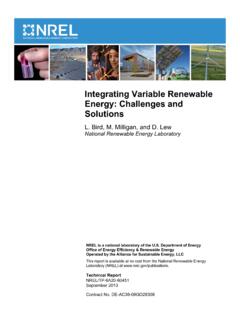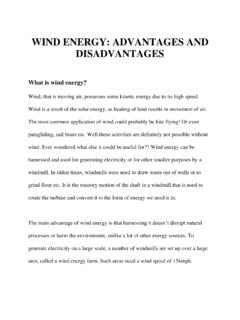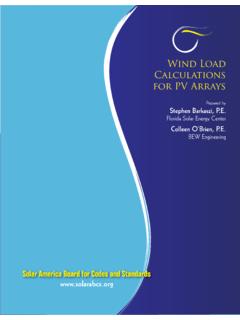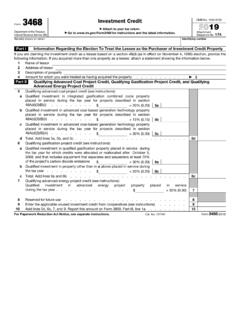Transcription of Solar Thermal Energy for Industrial Uses
1 Solar Thermal Energy for Industrial uses December 2011 INTRODUCTION Heat is often underappreciated in public policy discussions on Energy , frequently overshadowed by transportation Energy and electric power. However, heat accounts for 37 percent of Energy consumed within most developed countries, and 47 percent of the world s Energy While many people associate Solar Energy with electricity-producing photovoltaic (PV) panels, Solar can also be used for heating purposes. Solar Thermal Energy is most commonly used to heat outdoor swimming pools and residential water in the United States, but it can also be used for many types of Industrial This issue brief will examine the role that Solar Thermal technology currently plays in Industrial heating processes and outline opportunities for increased application within the Industrial sector. The Industrial sector is the leading source of Energy consumption in the United States.
2 At nearly one third of total Energy use, it exceeds both the transportation and residential Within the Industrial sector, nearly two thirds of Energy used is consumed as heat. Some industries have even higher rates, such as the glass industry, which consumes about 80 percent of its Energy for heating The remaining third can be attributed to electricity generation or Energy lost in transmission within the grid, or by inefficient conversion within the power plant Source: IEA, 2009. Depending on how Industrial Thermal Energy is defined, nearly 90 percent of the Energy comes from burning fossil fuels, but biomass can count for up to 11 The remaining 10 percent of Thermal Industrial Energy comes from electricity, which is often generated by power plants that burn fossil fuels. When including the environmental degradation from extracting fossil fuels, like mountaintop removal mining, water pollution from hydraulic fracturing of shale for natural gas, the air pollution emitted after their combustion, and large emissions of greenhouse gases, there is Environmental and Energy Study Institute 2 | P a g e a clear social incentive to find alternative sources of Energy .
3 Industry s role as the largest consumer of Energy in the nation, its large heat requirements, and its heavy reliance on fossil fuels, present tremendous opportunity for application of Solar Thermal technology. Solar : ELECTRICITY OR Thermal Solar Thermal collectors and Solar PV panels comprise the two main types of Solar Energy . PV panels convert Solar radiation into electricity, whereas Solar Thermal collectors convert the sun s rays directly into usable heat. Once the collector converts the sun s rays into heat, that heat can be used for a variety of purposes spanning all sectors of industry. Solar Energy is converted to electricity and heat at different rates. Solar conversion efficiency is the ratio of Energy produced from the panel or the collector to the Energy content of the sunlight itself. Solar Thermal conversion efficiency is approximately 70 percent compared to PV panels, which converts light to electricity at roughly 17 percent Despite a high conversion rate and wide-ranging application, Solar Thermal Energy is virtually absent from the Industrial sector.
4 According to the International Energy Agency (IEA), Solar Thermal Energy is a practical technology with much room for innovation which has been largely unexploited for Industrial As of 2008, there were only 90 Solar Thermal plants for Industrial process heating worldwide, comprising a combined 25 Thermal megawatts (MWth) of output. When compared to the 118 GWth of Solar output worldwide, this constitutes less than of total Solar Thermal As of 2011, there are fewer than 100 documented CHARACTERISTICS OF Industrial Thermal DEMAND Industrial heating needs can be categorized into three main temperature ranges. All of them can be achieved with Solar . The lowest temperature range consists of everything below 80oC. Solar collectors are capable of meeting these temperatures and are commercially available , 12 The medium temperature category is between 80oC and 250oC.
5 While the collectors servicing this level of heat demand are relatively limited, they do exist and are on the verge of emerging into competitive commercial The highest range includes everything over 250oC and requires concentrated Solar power (CSP) (see appendix) to achieve such temperatures. While CSP furnaces are rare a few have been installed in the United States for electricity production14 they can achieve temperatures as high as ,16 Many industries already can take advantage of the commercially available low and mid-range temperature Solar Thermal collectors. They are particularly suited to meet the heating needs of the food, beverage, textiles, paper and pulp industries. Processes like sterilizing, pasteurizing, drying, hydrolyzing, distillation and evaporation, washing and cleaning, and polymerization do not require high temperatures and can easily benefit from flat plate and evacuated tube collectors (see appendix, table below).
6 17 According to a study of Industrial heating in European countries, 30 percent of Industrial processing requires heat below 100oC and 27 percent of Industrial heating needs can be met with heat between 100-400oC, and 43 percent requires heat over 400 In the food, wine and beverage, transport equipment, textile, machinery, and pulp and paper industries, roughly 60 percent of the heating requirements can be met by temperatures below Despite tremendous opportunity, Solar Thermal heating for Industrial processes has been insignificant compared to the residential sector, and the few Industrial applications that do exist have been experimental in In 2005, the IEA s Solar Heating and Cooling (SHC) Program published a survey of existing technologies and identified research opportunities for improvements in efficiency and effectiveness. One objective of the program was to bridge the Environmental and Energy Study Institute 3 | P a g e gap between the large potential for Solar heating at medium temperatures, and the low commercial availability of appropriate Solar collectors.
7 While collectors capable of reaching 250oC are not yet commercially available, some researchers have indicated that the necessary improvements have been achieved and that the technology need only be scaled up for large scale INDUSTRY PROCESS TEMPERATURE(oC) Dairy Pressurization 60-80 Sterilization 100-120 Drying 120-180 Concentrates 60-80 Boiler feed water 60-90 Tinned food Sterilization 110-120 Pasteurization 60-80 Cooking 70-90 Bleaching 70-90 Textile Bleaching, dyeing 60-90 Drying, degreasing 100-130 Dyeing 70-90 Fixing 160-180 Pressing 80-100 Paper Cooking, drying 60-80 Boiler feed water 60-90 Bleaching 130-150 Chemical Soaps 200-260 Synthetic rubber 150-200 Processing heat 120-180 Pre-heating water 60-90 Meat Washing, sterilization 60-90 Cooking 90-100 Beverages Washing, sterilization 60-80 Pasteurization 60-70 Flours and by-products Sterilization 60-80 Timber by-products Thermo diffusion beams 80-100 Drying 60-100 Pre-heating water 60-90 Preparation pulp 120-170 Bricks and blocks Curing 60-140 Plastics Preparation 120-140 Distillation 140-150 Separation 200-220 Extension 140-160 Drying 180-200 Blending 120-140 Source: Mekhilef et al.
8 , 201122 Environmental and Energy Study Institute 4 | P a g e BARRIERS Despite the large potential for Solar Energy to meet Industrial Thermal demand, there are several barriers to large scale implementation. The most noteworthy barriers are cost, variability of output, Energy storage and process integration. Cost The economic viability of Solar Thermal Energy depends largely on two factors: the initial cost of the installation and the price of High upfront costs often prevent companies from investing in new technology, like Solar Thermal , even if the overall lifetime cost would be lower. However, while the cost of Solar technologies is decreasing, the financial investment in Solar remains more stable than many of the markets for fossil fuels. Thus, the largest driver of a collector s cost effectiveness is often the price of alternatives, like coal, oil and natural gas, not the cost of the collector The more expensive fossil fuels become, the easier it is to justify an investment in Solar Thermal Energy .
9 Nevertheless, if the price of Solar Thermal were to drop, it would certainly enhance its economic viability. With the volatility of fuel prices, some manufacturers opt for the fixed upfront cost (see case studies) with a predictable payback period. In addition to the potential for a lower overall cost, there exists a benefit from having a predictable cost structure which is insulated from fuel market volatility. Approximately 40 percent of Industrial primary Energy comes from natural gas, and approximately 41 percent comes from petroleum,25 two of the most price-volatile Energy sources available. Source: IEA, Source: IEA, Environmental and Energy Study Institute 5 | P a g e Furthermore, Solar Thermal collectors can be made even more cost effective when tailored to the specific process heating needs of the plant (see Process Integration below). On the factory level, large-scale applications can benefit from economies of scale and lowered investment costs, increasing its economic On the national level, the IEA estimates that costs can be reduced by as much as 20 percent when a country s total installed capacity Variability Solar Energy , like wind Energy , can be predicted to a high degree of confidence.
10 Its availability, however, presents challenges for industries that require 24/7 demand. The reliability of the heating supply is of paramount concern to many manufacturers for whom an unanticipated disruption in production can be economically devastating. Solar Thermal Energy is reliable but not always available. Therefore, industries which either do not require constant production, or for whom the sunlight availability can be aligned with heating requirements, may be more confident about integrating Solar Thermal Energy into their production. The variability of sunlight can also be mitigated by conducting statistical analyses of heating requirements vis- -vis the regional insolation the irradiance per square meter over a given period of time. This can be conducted as part of a procedure known as process integration (see below). Another possible solution is to store heat for later use to smooth the gaps in sunlight availability (see below).



